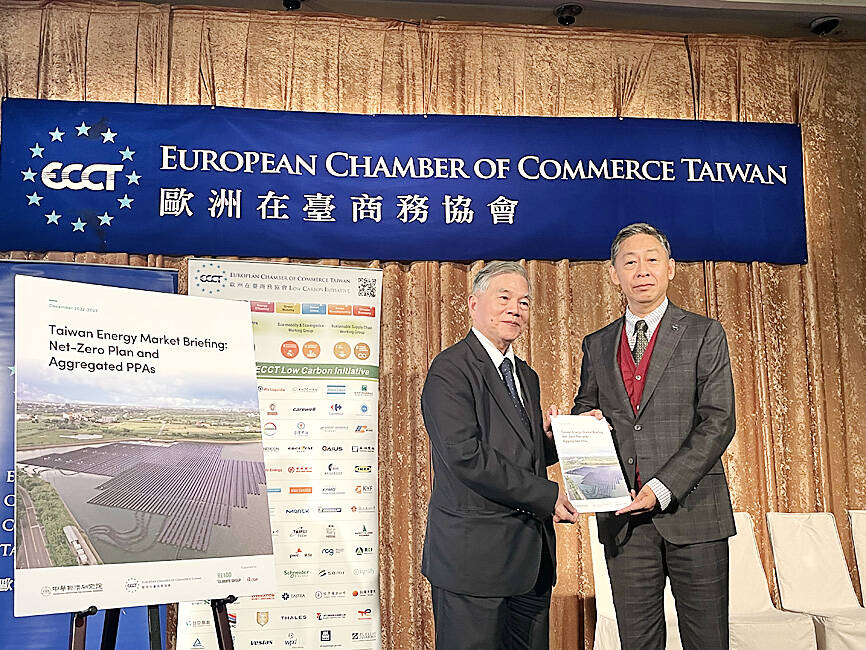Taiwanese companies are struggling to procure renewable energy domestically, as the grid is not meeting demand in terms of supply and access, meaning the nation would likely fall short of its renewable energy goals for 2025, the RE100 global initiative said in a report.
The report, titled “Taiwan Energy Market Briefing: Net-Zero Plan and Aggregated PPAs,” was released on Wednesday with the European Chamber of Commerce Taiwan. It was sponsored by Cathay Financial Holdings Co (國泰金控), Grape King Bio Ltd (葡萄王), Hua Nan Commercial Bank (華南金控), Taiwan Mobile Co (台灣大哥大) and PwC Taiwan (資誠聯合會計師事務所).
Demand for renewable energy has increased in the past few years, as RE100 members progress toward their targets, the report said.

Photo: Hsu Tzu-ling, Taipei Times
More Taiwanese companies have committed to using renewable energy, while heavy power consumers are being pushed through legislation to use more green energy, it said.
RE100 is a global initiative bringing together influential businesses devoted to using 100 percent renewable electricity at their facilities.
However, high costs and low supply remain the two biggest reasons for a lack of corporately sourced renewable energy in Taiwan, compared with two years ago when high costs, low supply and lack of market transparency were identified as the main barriers, the report said.
Bundled renewable energy certificates are expensive in Taiwan and corporate power purchase agreements are costly, as they require that buyers be large electricity consumers and sign 10 to 20-year contracts, it said.
That makes purchasing bundled renewable energy certificates economically not feasible, while corporate power purchase agreements are limited to a few companies that meet the requirements, it added.
The rules make most RE100 members with operations in Taiwan unable to pass the criteria, the report said.
One possible solution is an aggregated power purchase agreement (APPA) that would bring together two or more companies to negotiate and purchase renewable energy, it said.
By doing so, developers and purchasers would benefit from economies of scale, the report said, adding that corporations and stakeholders seem eager to join forces to overcome barriers that appear significant.
Vice Premier Shen Jong-chin (沈榮津) said that while APPAs would not necessarily reduce electricity costs and could involve longer contract periods, they might allow partner companies to achieve economies of scale.
He said he would ask the Bureau of Energy to look into the suggestion and brief him.
Government figures showed that renewable energy accounted for 6.3 percent of Taiwan’s total power supply last year, a slight increase from 5.8 percent in 2020, the report said.
While the government had previously committed to increasing the share of electricity generated from renewable energy sources to 20 percent by 2025, the report estimated that this goal was unlikely to be reached until 2026 or 2027.
Additional reporting by CNA

CHIP RACE: Three years of overbroad export controls drove foreign competitors to pursue their own AI chips, and ‘cost US taxpayers billions of dollars,’ Nvidia said China has figured out the US strategy for allowing it to buy Nvidia Corp’s H200s and is rejecting the artificial intelligence (AI) chip in favor of domestically developed semiconductors, White House AI adviser David Sacks said, citing news reports. US President Donald Trump on Monday said that he would allow shipments of Nvidia’s H200 chips to China, part of an administration effort backed by Sacks to challenge Chinese tech champions such as Huawei Technologies Co (華為) by bringing US competition to their home market. On Friday, Sacks signaled that he was uncertain about whether that approach would work. “They’re rejecting our chips,” Sacks

Taiwan’s long-term economic competitiveness will hinge not only on national champions like Taiwan Semiconductor Manufacturing Co. (TSMC, 台積電) but also on the widespread adoption of artificial intelligence (AI) and other emerging technologies, a US-based scholar has said. At a lecture in Taipei on Tuesday, Jeffrey Ding, assistant professor of political science at the George Washington University and author of "Technology and the Rise of Great Powers," argued that historical experience shows that general-purpose technologies (GPTs) — such as electricity, computers and now AI — shape long-term economic advantages through their diffusion across the broader economy. "What really matters is not who pioneers

TAIWAN VALUE CHAIN: Foxtron is to fully own Luxgen following the transaction and it plans to launch a new electric model, the Foxtron Bria, in Taiwan next year Yulon Motor Co (裕隆汽車) yesterday said that its board of directors approved the disposal of its electric vehicle (EV) unit, Luxgen Motor Co (納智捷汽車), to Foxtron Vehicle Technologies Co (鴻華先進) for NT$787.6 million (US$24.98 million). Foxtron, a half-half joint venture between Yulon affiliate Hua-Chuang Automobile Information Technical Center Co (華創車電) and Hon Hai Precision Industry Co (鴻海精密), expects to wrap up the deal in the first quarter of next year. Foxtron would fully own Luxgen following the transaction, including five car distributing companies, outlets and all employees. The deal is subject to the approval of the Fair Trade Commission, Foxtron said. “Foxtron will be

BUBBLE? Only a handful of companies are seeing rapid revenue growth and higher valuations, and it is not enough to call the AI trend a transformation, an analyst said Artificial intelligence (AI) is entering a more challenging phase next year as companies move beyond experimentation and begin demanding clear financial returns from a technology that has delivered big gains to only a small group of early adopters, PricewaterhouseCoopers (PwC) Taiwan said yesterday. Most organizations have been able to justify AI investments through cost recovery or modest efficiency gains, but few have achieved meaningful revenue growth or long-term competitive advantage, the consultancy said in its 2026 AI Business Predictions report. This growing performance gap is forcing executives to reconsider how AI is deployed across their organizations, it said. “Many companies